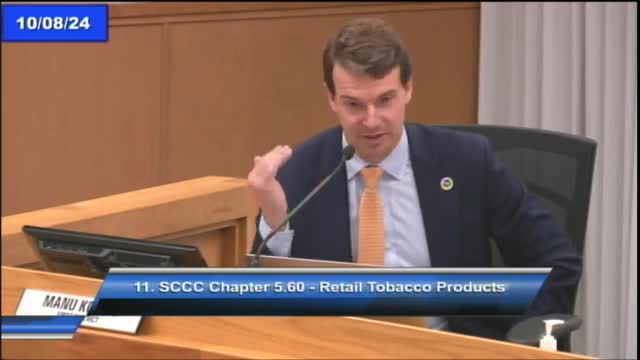Efforts intensify to ban toxic cigarette filters
October 17, 2024 | Santa Cruz County, California
This article was created by AI summarizing key points discussed. AI makes mistakes, so for full details and context, please refer to the video of the full meeting. Please report any errors so we can fix them. Report an error »

In a recent government meeting, officials discussed the implications of a proposed ban on toxic cigarette filters, emphasizing the need to address both public health and environmental concerns. The meeting highlighted a thorough economic analysis indicating that while the demand for tobacco products dipped following the implementation of a flavored tobacco ban, it eventually rebounded as consumers adapted.
One official articulated a strong stance against the freedom to smoke, arguing that the health risks associated with toxic cigarette filters disproportionately affect the 94% of the community that does not smoke. They described cigarette butts as the most littered item globally, posing significant environmental hazards. The call to action was clear: to ban what they termed \"toxic trash\" for the sake of public health and environmental cleanliness.
The discussion also touched on the broader context of plastic pollution, with officials noting that cigarette butts are a primary source of litter on local beaches. Comparisons were made to other jurisdictions, such as Manhattan Beach and Beverly Hills, which have enacted comprehensive bans on all tobacco products. The officials expressed a commitment to a data-driven approach, focusing on the specific pollution caused by cigarette butts rather than a blanket ban on all tobacco products.
Acknowledging the challenges faced by retailers, officials indicated a willingness to provide time for adjustment, citing examples from other cities that allowed for gradual implementation of similar bans. They also addressed the financial implications of smoking, highlighting the costs associated with public health education and treatment for smoking-related illnesses, particularly in low-income communities that have been targeted by tobacco marketing.
The meeting concluded with a commitment to engage with other jurisdictions and gather more information over the next two years, aiming for a coordinated approach to tobacco regulation that prioritizes public health and environmental sustainability.
One official articulated a strong stance against the freedom to smoke, arguing that the health risks associated with toxic cigarette filters disproportionately affect the 94% of the community that does not smoke. They described cigarette butts as the most littered item globally, posing significant environmental hazards. The call to action was clear: to ban what they termed \"toxic trash\" for the sake of public health and environmental cleanliness.
The discussion also touched on the broader context of plastic pollution, with officials noting that cigarette butts are a primary source of litter on local beaches. Comparisons were made to other jurisdictions, such as Manhattan Beach and Beverly Hills, which have enacted comprehensive bans on all tobacco products. The officials expressed a commitment to a data-driven approach, focusing on the specific pollution caused by cigarette butts rather than a blanket ban on all tobacco products.
Acknowledging the challenges faced by retailers, officials indicated a willingness to provide time for adjustment, citing examples from other cities that allowed for gradual implementation of similar bans. They also addressed the financial implications of smoking, highlighting the costs associated with public health education and treatment for smoking-related illnesses, particularly in low-income communities that have been targeted by tobacco marketing.
The meeting concluded with a commitment to engage with other jurisdictions and gather more information over the next two years, aiming for a coordinated approach to tobacco regulation that prioritizes public health and environmental sustainability.
View full meeting
This article is based on a recent meeting—watch the full video and explore the complete transcript for deeper insights into the discussion.
View full meeting
